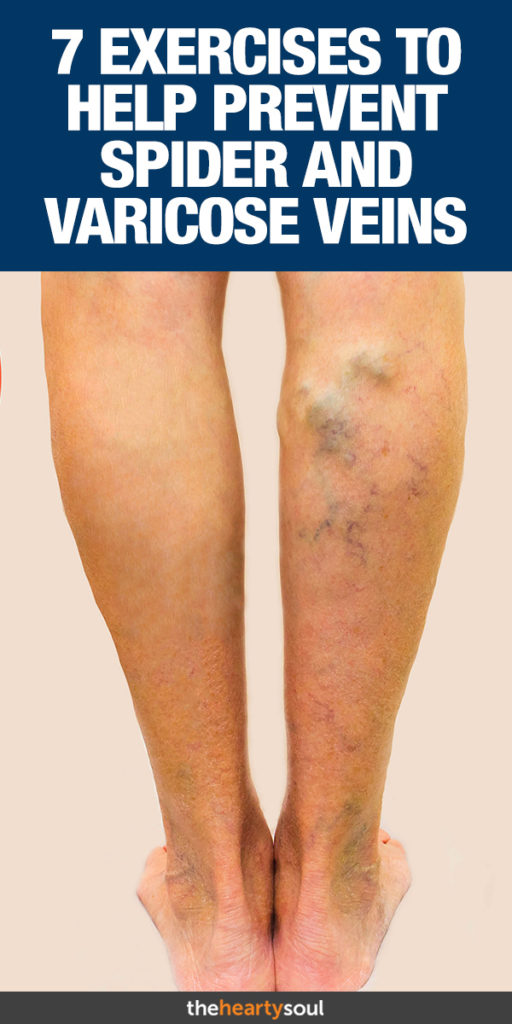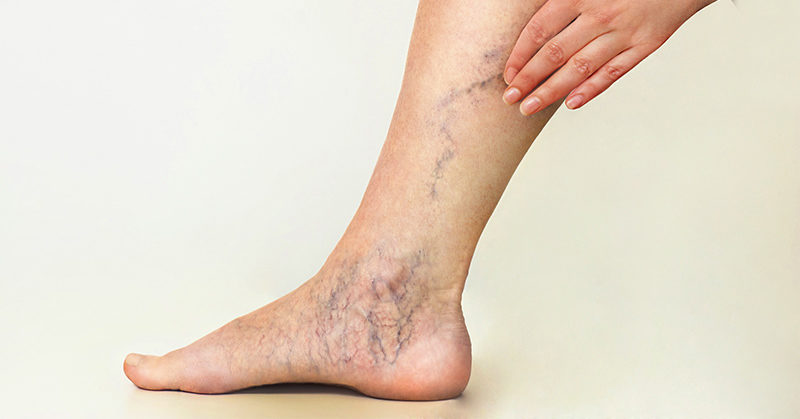It is estimated that about twenty percent of all adults will develop varicose veins at some point in their lifetime [1].
They tend to be more common in women than men, and more than forty percent of women have some kind of varicose vein condition including spider veins, with the prevalence of these venous diseases increasing with age. By the age of eighty, up to eighty percent of women have some kind of venous disease [2].
Varicose veins cause rather unsightly, highly visible, misshapen veins to appear on your legs, which can sometimes be painful, and cause swelling, heaviness, and achiness around the affected area.
Unfortunately, you cannot completely get rid of this condition without medical intervention, however there are some steps you can take to prevent spider or varicose veins from worsening, or to slow down their development.
Spider Veins Vs. Varicose Veins
Although these two terms occasionally get interchanged, they are two different conditions that are related, but have a few key differences.
Spider veins are also known as superficial leg veins. They occur when tiny veins congregate below the skin’s surface and cause red, blue, or purple discolorations. They can be quite small, but can also be large and noticeable, however they are not dangerous to your health. In most cases, spider veins are treated for cosmetic reasons only [3].
Varicose veins are swollen, twisted veins that lie beneath the skin’s surface, and like spider veins, typically occur on the legs [4].
What Causes Them?
The exact cause of spider veins is unknown, however most experts agree that a variety of factors, like heredity, pregnancy, trauma, aging, sun damage, and hormonal influences are the primary factors contributing to the condition [2].
Varicose veins, on the other hand, are caused by weak or damaged vein walls and valves. They could form whenever the blood pressure in your veins increases, which could happen as a result of pregnancy, constipation, a tumor, or if someone is overweight or obese [4].
All veins have one-way valves inside them that open and close to ensure blood continues to flow to the heart. If these become damaged or weakened, blood can start to pool or even flow backwards, a condition called reflux. When this happens, veins can become large and distorted, causing varicose veins [4].
Although varicose veins occur most commonly in the legs, they can also happen in other parts of the body. For example, hemorrhoids are a type of varicose vein that occurs in the rectum, varicoceles occur in the testicles, and varicose veins can also appear in the esophagus, stomach, or liver.
People who are older, or who sit or stand for long periods of time, have an inactive lifestyle, are overweight or obese, or who have a family history of varicose veins or deep vein thrombosis are at a higher risk for developing varicose veins, as well as pregnant women, or women who have had multiple births [4].
Read: The 14 Best Foods to Increase Blood Flow and Circulation
How to Help Prevent Spider and Varicose Veins
Unfortunately, there isn’t really a definitive way to prevent varicose veins from forming, since many of the most prominent risk factors (like family history, age, or gender) are unavoidable. That being said, you can help prevent existing varicose veins from worsening, and there are steps you can take to delay problems with veins as long as possible:
1. Avoid sitting or standing for long periods of time
This can make it harder for the blood in your veins to travel because of gravity, causing the pressure in your veins to rise. Moving around can help prevent this, and even just peddling your feet while sitting at your desk can make a difference.
2. Wear compression clothing
Compression socks, tights, or stockings can help keep your veins’ valves in the right position, making it easier for them to function and therefore reducing blood pooling, swelling, and pain.
3. Live a healthy lifestyle
Because so many of the risk factors for varicose veins are out of your control, it is important that you take advantage of the ones that are in control in order to prevent them from happening. Eating a healthy diet, getting good sleep, and drinking plenty of water can help you to avoid obesity and prevent more damage to your veins.
4. Pregnant women- sleep in the right position
Pregnancy is one of the biggest risk factors for varicose veins, but simply sleeping in the correct position can help lower that risk. Sleeping on the left side of your body helps to reduce the pressure that your expanding uterus exerts on the large vein in your pelvic area, which can help prevent varicose veins from forming and ease the symptoms from those that already exist.
5. Exercise
Walking is the best exercise to help prevent varicose veins from forming, but yoga, swimming, and cycling are also excellent ways to keep blood flowing easily and help the vein valves to work properly [5].
Read: 10 Core Exercises That Are Important for Every Woman
Exercises to Help Prevent Spider and Varicose Veins
While activities like walking, cycling, swimming, and yoga, are all excellent ways to prevent spider and varicose veins from forming, there are also a number of simple exercises that can be done almost anywhere that can help keep your veins strong and healthy.
The following seven exercises have been put together by Bright Side, and can help to reduce the symptoms and occurrence of spider and varicose veins:
1. Bicycle Kicks
If it’s a rainy day outside, or if you don’t have a bike to ride, this exercise stimulates the calf muscles and helps keep your blood flowing in the right direction. There are three simple steps to performing this exercise:
- Lie down on your back and raise your legs in the air to make a 90-degree angle.
- Slowly kick your right leg out while keeping your left leg bent.
- Return your right leg to the starting position, switch, and repeat.
2. Leg Lifts
This exercise can improve blood circulation in your veins. Here are the steps:
- Lie flat on your back.
- Lift one leg at a time.
- Hold your leg in the air for a few seconds.
- Change legs and repeat.
3. Lunges
Exercising your leg muscles increases the amount of blood flow to your heart, which forces your heart to work harder and helps to keep your veins in good shape:
- Stand up straight with your arms held down at your sides.
- Take a big step forward with your left foot.
- Begin to bend your left knee while keeping your back straight, your eyes looking forward, and your arms at your sides.
- Bend your left knee until it reaches a 90-degree angle.
- Hold this pose for 10 seconds and then return to a standing position.
4. Calf Raises
Calf raises improve the strength of your calf muscles and improve blood circulation. They are very simple to do, and can be performed almost anywhere:
- Stand up straight with your legs parallel.
- Slowly raise your toes, stretching your calf muscles.
- Lower your toes to the floor and raise your heels, repeating as many times as you feel comfortable.
5. Standing Heel and Toe Raises
This exercise is similar to calf raises, only it also helps improve your balance:
- Stand up straight with your heels together, toes pointed out.
- Rise up on your tiptoes.
- Slowly lower back down.
- Rock back to your heels, toes off the ground.
6. Toe Flexes
This can be performed anywhere where you are able to sit on the floor with your legs stretched out in front of you:
- Stretch out your toes forward as far as you can, then back.
- Repeat this rhythmically for 20 times per leg.
7. Elevate Your Legs
Doctors recommend that those who struggle with spider or varicose veins elevate their legs at or above heart level whenever possible to relieve swollen or achy legs and to improve blood flow whenever possible:
- Lie on your back on the floor or on your bed.
- Raise your legs straight up in the air or prop them against the wall.
- Hold this position for a few minutes and then lower your legs to the ground.
Bonus: cold showers can improve blood circulation and make blood less likely to pool in your veins [6].
Mitigating Risk Factors is the Key
Again, it is important to remember that many of the risk factors for developing spider and varicose veins are unavoidable, since there’s not much you can do about your genetics, family history, age, or gender.
That being said, if you are concerned about developing either condition, it is crucial that you mitigate the risk factors that you can control in order to prevent them. While there are a number of small things you can do to help, exercise and movement is one of the best ways to keep your veins healthy, so if you want to keep spider and varicose veins at bay, keep moving!
Keep Reading: What Causes Varicose Veins and How to Help Get Rid of Them, According to Traditional Chinese Medicine

Sources
- https://www.ncbi.nlm.nih.gov/books/NBK279247/#:~:text=Prevalence,in%20women%20than%20in%20men.
- https://www.asds.net/skin-experts/skin-conditions/spider-veins#:~:text=More%20than%2040%20percent%20of,have%20varicose%20and%20spider%20veins.
- https://www.health.harvard.edu/a_to_z/spider-veins-a-to-z
- https://www.nhlbi.nih.gov/health-topics/varicose-veins
- https://www.healthline.com/health/how-to-prevent-varicose-veins#exercise
- https://brightside.me/inspiration-health/7-exercises-to-reduce-spider-and-varicose-veins-798269/

